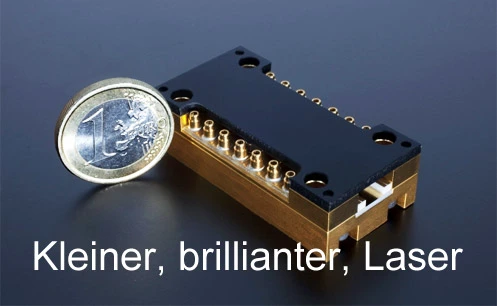“Some day holograms will leap through our homes”
FBH Developed Compact Brilliant Laser Light Source
Scientists from the Ferdinand-Braun-Institut (FBH) have developed small, compact brilliant laser light sources, which enable significantly smaller systems for laser projectors and other display technologies.
“This rollercoaster ride made me feel really sick,” said Dr. Katrin Paschke, head of a junior research group at the FBH – although she has not even been sitting in the wagon, but watching the ride in a film. The particularly realistic pictures were produced by a specific projection technology.
“With laser projection ninety percent of the color space of the human eye can be covered. Thus, the image quality is fascinating. Today’s flat screens manage only about fifty percent,” said Paschke.
The major disadvantage of laser projectors so far is their vast dimensions. In flight simulators for example, laser systems the size of a cabinet are used — a fact that considerably limits applications and makes one easily understand why the technology is not yet ready for home television sets. Scientists therefore develop increasingly smaller devices, which need to achieve high optical output powers in the Watt range and an excellent beam quality at the same time.
Paschke and her team have developed red laser light sources within InnoProfile, an initiative funded by the German Federal Ministry of Education and Research, and a development contract with LDT Laser Display Technology GmbH from Jena. LDT projects to integrate these laser modules, which have been miniaturized to a unit the size of a matchbox, into their next-generation laser projectors.
Into their red emitting micro modules, FBH’s scientists combined several elements such as laser chip and micro optics. The red light is generated directly by rice-grain-sized semiconductor lasers. As high output powers are needed for display systems, one of the challenges was to reduce the extraordinary high power densities to prevent the laser material from melting. Consequently, power should not concentrate on an aperture being too small.
FBH has developed a laser chip, which trapezoidally broadens toward the opening: A laser beam with good beam quality can thus be generated compactly and enlarges then in the tapered section. As a result, the high output powers can be spread over a comparatively broad opening of several hundred micro meters. In order to make the radiation of the laser modules usable for laser projection, the beam has to be collimated afterwards, which means it has to be adjusted in parallel. As a matter of fact, the beam a semiconductor laser usually emits is broadening with increasing distance and thus loses intensity. As the entire module should not exceed the size of a matchbox, custom-built micro optics (approx. 1 x 1 x 1 mm³) were used. They had to be positioned and fixed with highest precision of under one micro meter. Additionally, an elaborated thermal management ensures that the diode lasers can be operated under optimum thermal conditions of below 15°C. To dissipate excessive heat, FBH’s scientists use specifically manufactured industrial diamonds.
With these tiny little brilliant laser light sources, Paschke and her team do not only want to make sure, that pin sharp pictures are generated in planetaria and flight simulators. Life-like pictures shall also be delivered into consumer’s living rooms. She expects even more for the entertainment sector.
“Some day holograms will leap through our homes,” she said.
For more information, visit: www.fbh-berlin.com
Contact:
Petra Immerz
Communications & Public Relations
Ferdinand-Braun-Institut, Leibniz-Institut für Höchstfrequenztechnik
Gustav-Kirchhoff-Straße 4
12489 Berlin, Germany
Phone: +49.30.6392-2626Fax: +49.30.6392-2602Email: petra.immerz@fbh-berlin.de
Released at www.photonics.com/Article.aspx?AID=45447
